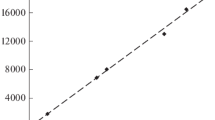Summary
Calcium carbonate labeled with carbon-14 was self-irradiated by means of the β-decay of its carbon-14. A number of products containing one or two carbon atoms were identified by high performance liquid chromatography. Formic and oxalic acids were produced in relatively high yields, while glyoxylic, glycolic, and acetic acids, as well as formaldehyde and methanol, were formed in lower yields. These results support the suggestion that carbonates subjected to ionizing radiation could have been a source of carbon for organic synthesis on the primitive earth.
Similar content being viewed by others
References
Albarrán G, Collins CH (1987) Application of ion-moderated partition chromatography to the determination of Ca14CO3 and Ba14CO3 self-radiolysis products. J Chromatogr (in press)
Apers DJ, Debuyst R, Dejehet F, Lombard E (1980) A propos d'un essai de datation par RPE de concretions calcaires originaires de grottes belges. Radiochem Radioanal Lett 45:427–440
Broda E (1975) The evolution of the bioenergetic processes. Pergamon Press, London
Bullard E (1952) In: Kuiper GP (ed) The atmosphere of the earth and planets. University of Chicago Press, Chicago
Calderon T, Aguilar M, Jaque F, Coy-yel R (1984) Thermoluminescence from natural calcites. J Phys C Solid State Phys 17:2027–2038
Cass J, kent RS, Marshall SA, Zager SA (1974) Electron spin resonance absorption spectrum of HCO3 2− molecule-ions in irradiated single-crystal calcite. J Magn Reson 14:170–181
Castillo-Rojas S, Negron-Mendoza A, Draganić ZD, Draganić IG (1985) The radiolysis of aqueous solutions of malic acid. Radiat Phys Chem 26:437–443
Collins CH, Collins KE, Ackerhalt RE, Blau M (1975) Chemical forms of tritium in reactor produced fluorine-18. Int J Appl Radiat Isot 26:571–572
Collins KE, Collins CH (1977) Annealing of tritium labelled products in reactor irradiated lithium carbonate. J Inorg Nucl Chem 39:745–748
Collins KE, Farris MG, Costa-Pereira SCL, Collins CH (1982) Organic products observed in self-radiolyzed Ba14CO3. In: Jiménez-Reyes M (ed) Memorias del IV simposio sobre Química Nuclear, Radioquímica y Química de Radiaciones, UNAM, México, DF, pp 57–60
Cunningham J (1967) Electron-hole trapping in X-irradiated calcium carbonate and sodium nitrate. J Phys Chem 71:1967–1970
Debenham NC (1983) Reliability of thermoluminescence dating of stalagmitic calcite. Nature (London) 304:154–156
Draganić IG, Draganić ZD, Altiparmokov D (1983) Natural nuclear reactors and ionizing radiation in the Precambrian. Precambrian Res 20:283–298
Edwards WJ, McCallum KJ (1956) Chemical effects of the C12(γ,n)C11 reaction in carbonates. Can J Chem 34:189–192
Farris MG, Cruz PEN, Collins KE (1979) Dissolução de carbonatos metálicos no sistema resina-H2O. Quím Nova 2:129
Hisatsune IC, Adl T, Beahm EC, Kempf RJ (1970) Matrix isolation and decay kinetics of carbon dioxide and carbonatc anion free radicals. J Phys Chem 74:3225–3231
Hubbard JS, Hardy JP, Horowitz NH (1971) Photocatalytic production of organic compounds from CO and H2O in a simulated Martian atmosphere. Proc Natl Acad Sci USA 68: 574–578
Ikeya M (1975) Dating a stalactice by electron paramagnetic resonance. Nature (London) 255:48–50
Kolbe WF, Smakula A (1961) Anisotropy of color centers in calcite. Phys Rev 124:1754–1757
Kolomnikov IS, Lysyak TV, Konash EA, Kalyazin EP, Rudnev AV, Kharitonov YY (1982) Formation of organic products from metal carbonates and water by the action of ionizing radiation. Dokl Phys Chem 25:596–597
Macdougall JD, Lugmair GW, Kerridge JF (1984) Early solar system aqueous activity: strontium isotope evidence from the Orgueil CI meteorite. Nature (London) 307:249–251
Marshall SA, Reinberg AR, Serway RA, Hodges JA (1964) Electron spin resonance absorption spectrum of CO −2 moleculeions in single crystal calcite. Mol Phys 8:225–231
Marshall SA, McMillan JA, Nistor SV (1974) Superhyperfine structure of the ESR spectra of CO2 − and CO3 3− moleculeions in single-crystal calcite. J Magn Reson 14:20–30
Miller SL, Orgel LE (1974) The origins of life on the earth. Prentice-Hall, Englewood Cliffs
Negron-Mendoza A, Draganić ZD, Navarro-Gonzáles R, Draganić IG (1983) Aldehydes, ketones, and carboxylic acids formed radiolytically in aqueous solutions of cyanides and simple nitriles. Radiat Res 95:248–261
Perrin DD, Armarego WLF, Perrin DR (1966) Purification of laboratory chemicals. Pergamon Press, New York
Pfeiffer K, Rank D, Techurlovits M (1981) A method for counting14C as CaCO3 in a liquid scintillator with improved precision. Int J Appl Radiat Isot 32:665–667
Sandford SA (1986) Acid dissolution experiments: carbonates and the 6,8-micrometer band in interplanetary dust particles. Science 231:1540–1541
Serway RA, Marshall SA (1967) Electron spin resonance absorption spectra of CO3 − and CO3 3− molecule-ions in irradiated single-crystal calcite. J Chem Phys 46:1949–1952
Sharman LJ, McCallum KJ (1955) Chemical effects of the C12(γ,n)C11 reaction in anhydrous sodium carbonate. J Am Chem Soc 77:2989–2992
Suess E, Balzer W, Hesse KF, Müller PJ, Ungerer CA, Weter G (1982) Calcium carbonate hexahydrate from organic-rich sediments of the Antarctic shelf: precursors of glendonites. Science 216:1128–1131
Tomeoka K, Buseck PR (1986) A carbonate-rich, hydrated, interplanetary dust particle: possible residue from protostellar clouds. Science 231:1544–1546
Author information
Authors and Affiliations
Rights and permissions
About this article
Cite this article
Albarrán, G., Collins, K.E. & Collins, C.H. Formation of organic products in self-radiolyzed calcium carbonate. J Mol Evol 25, 12–14 (1987). https://doi.org/10.1007/BF02100035
Received:
Revised:
Issue Date:
DOI: https://doi.org/10.1007/BF02100035



